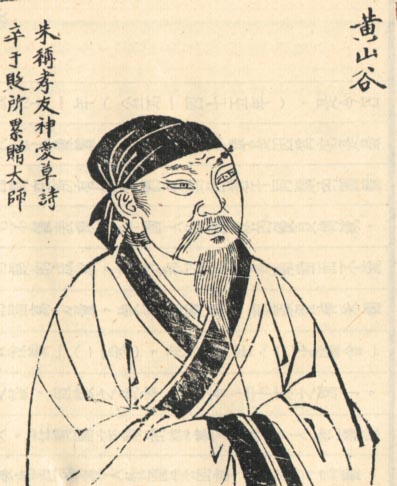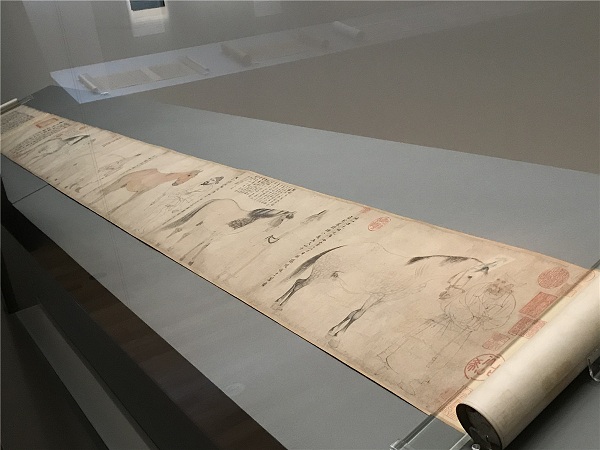
2022 marks the 50th anniversary of the normalization of diplomatic relations between China and Japan, and the 150th anniversary of the establishment of the Tokyo National Museum in Japan.
The Paper was informed that on September 21, the exhibition "Excellent Chinese Painting and Calligraphy - Song Dynasty Painting and Calligraphy and Its Inheritance and Development" opened at the Tokyo National Museum in Japan. This exhibition will be displayed in two phases, many of which are famous in the history of Chinese painting and calligraphy. Among the exhibits in the first phase, the most eye-catching are Huang Tingjian's "Wang Shi Er's Epitaph Scroll", Ma Yuan's "Hanjiang Alone Fishing Scroll", etc.; and in the second phase of the exhibits, there are three years apart. Li Gonglin's "Five Horses Scroll", Liang Kai's "Li Bai's Walking Scroll", and Mi Fu's "Three Posts in Running Script" were exhibited again.
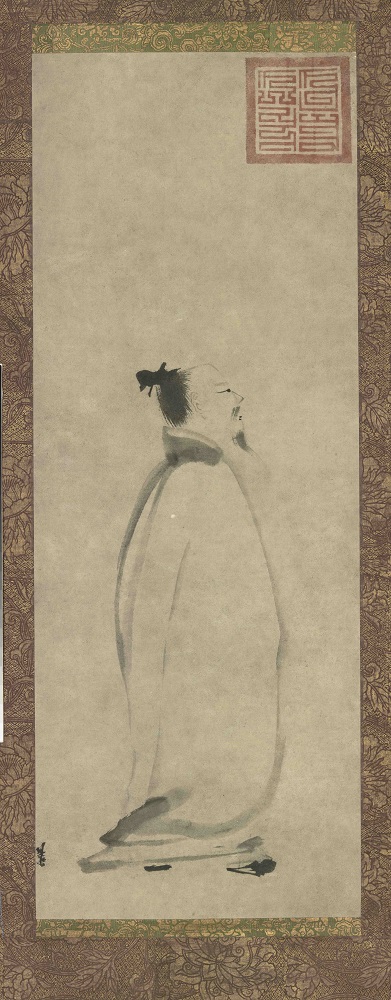
Liang Kai's "Li Bai Yin Travel Chart Scroll"
Regarding this exhibition, the Tokyo National Museum introduced on its official website: "The exhibition of Chinese calligraphy and painting is a regular exhibition in the autumn of the museum. This year marks the 50th anniversary of the normalization of Sino-Japanese diplomatic relations and the 150th anniversary of the establishment of the Tokyo National Museum. On this occasion , this exhibition not only introduces the works of the Northern Song Dynasty (960-1127) and Southern Song Dynasty (1127-1279), which have been loved by Japanese since ancient times, from the fine Chinese paintings collected or kept in the museum, but also introduces in-depth The treasures of calligraphy and painting in the Yuan, Ming and Qing dynasties created under the influence of the paintings of the Song Dynasty are gathered here, so that all the guests can experience the pivotal status of the paintings of the Song Dynasty in the painting world."
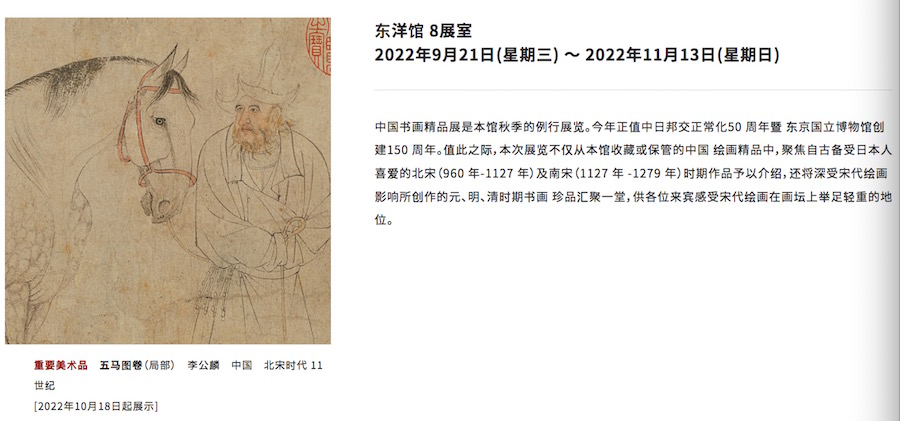
Introduction to the exhibition on the official website of the Tokyo National Museum
The Paper learned that most of the exhibits in this exhibition are presented in two phases, the first phase is from September 21 to October 16, and the second phase is from October 18 to November 13.
From the introduction on the official website, it can be seen that the main exhibition works of this boutique exhibition are 15 pieces. The important exhibits in the first phase are Huang Tingjian's running script "Wang Shi Er's Epitaph Manuscript Scroll" in the Northern Song Dynasty, and (biography) Ma Yuan's "Hanjiang Fishing Alone" in the Southern Song Dynasty Chart Scroll, "Dongshan Crossing the Water Chart Scroll", (biography) Zhao Chang's "Bamboo Insect Scroll" in the Southern Song Dynasty, (biography) Chen Rong's "Five Dragons Scroll" in the Southern Song Dynasty, etc.; and in the second issue, the key exhibits are the Northern Song Dynasty Li Gonglin's "Five Horses Scroll", Mi Fu's "Three Posts in Running Script" in the Northern Song Dynasty, and Liang Kai's "Li Bai Yin Xing Tu Scroll" in the Southern Song Dynasty.
The first phase:
Huang Tingjian's running script "Wang Shi Er's Epitaph Manuscript Scroll"
Among the exhibits in the first issue, Huang Tingjian's running book "Wang Shi Er's Epitaph Manuscript Scroll" is undoubtedly the most important. This exhibit was once collected by Duanfang and Abe Fangjiro, and has been repeatedly recorded.

Huang Tingjian's running script "Wang Shi Er's Epitaph Manuscript Scroll"
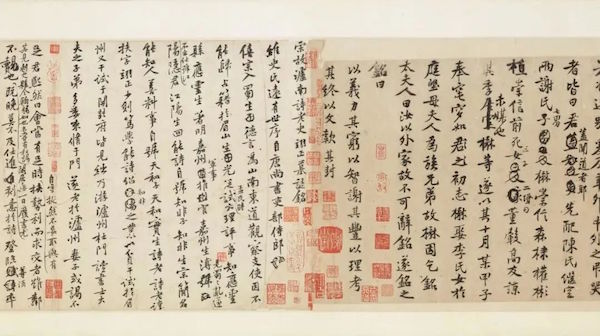
Huang Tingjian's running script "Wang Shi Er's Epitaph Manuscript Scroll"
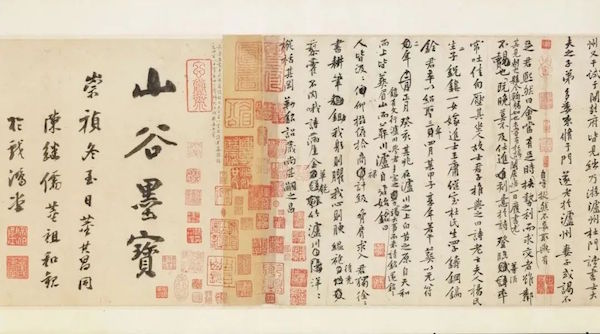
Huang Tingjian's running script "Wang Shi Er's Epitaph Manuscript Scroll"
Huang Tingjian's "Wang Shi Er's Epitaph Draft" is a combination of "Wang Changzhe's Epitaph Draft" and "Song Lunan Poetry Lao Shi Yizheng's Epitaph Draft". Among them, the draft of "Wang Elder's Epitaph" has twenty-two lines, and the lines vary from fourteen to five characters. The text of the full manuscript has been altered or added in more than 40 places, or it is not the final version. The elder Wang, whose name was Lu, styled Yongyu, was from Haihun (now Yongxiu County, Jiangxi Province). He was good at business and wealthy in the township, and built a library to collect books. Later, he divided the family business among the sons, and then roamed the world and lived in famous temples in central Jiangxi. Wang died in the first month of Yuanyou Bingyin (1086), at the age of sixty-two, and was buried in "a certain Jiazi in October". Wang Mao, the eldest son of Wang's family, married his wife, Li, and was related to Huang Tingjian's family by marriage (distant relative). Wang Mao asked Huang Tingjian to write an epitaph, so he could not refuse. Because of human affection, Huang Tingjian may not know the Wang family very well, so he carefully considered every word and added or deleted it. This epitaph has no signature or date, because it contains "Yuanyou Bingyin the first month Xinmao ends" and "Mao et al. took a certain Jiazi in October and honored him as the first will". In the Book of Paintings and Calligraphy, the epitaph is determined to be written by Yuanyou Bingyin, when the valley was forty-two years old.
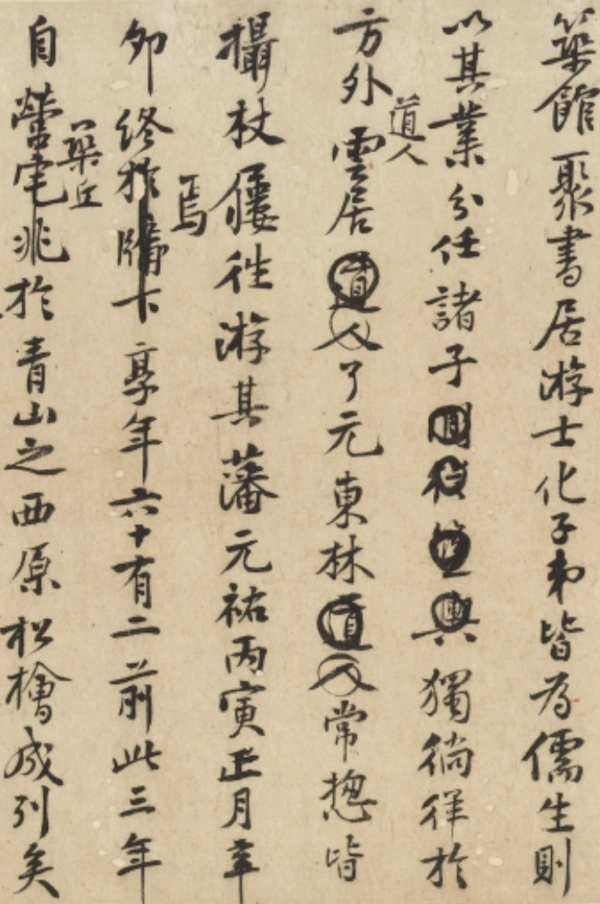
"Draft of Wang Elder's Epitaph" (detail)
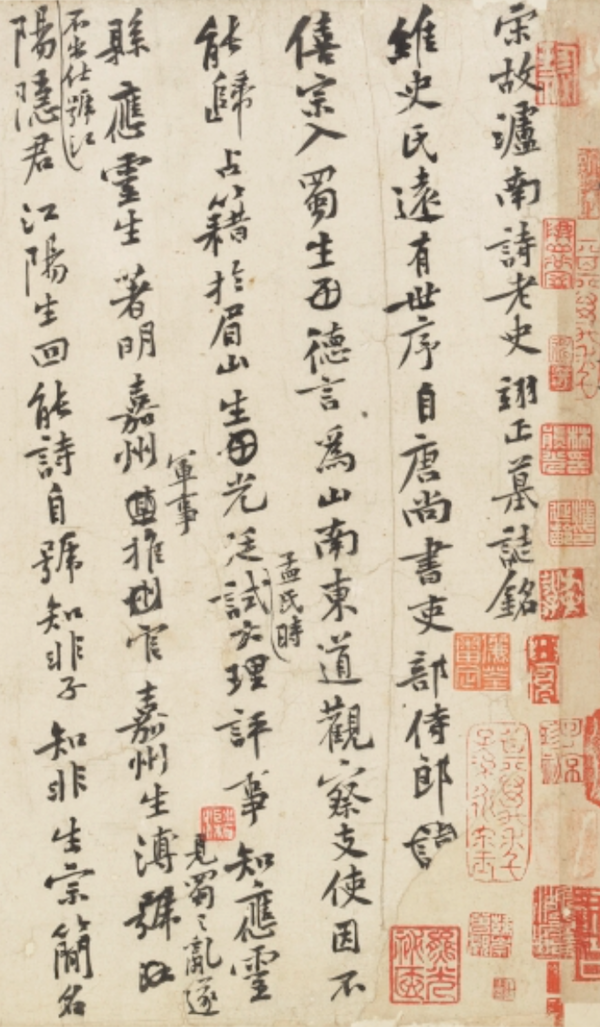
"Song Lunan Poem Lao Shi Yizheng's Epitaph Draft" (part)
And "Song Lunan Poetry Lao Shi Yizheng Epitaph Inscription", if there are twenty lines, five lines are added, and the lines are about twenty characters. The text of the whole manuscript has been altered in about 20 places, and it is not the final version. "Lunan Shi Lao" Shi Fu, the word Yizheng. The Shi family entered Shu during the reign of Emperor Xizong of the Tang Dynasty and occupied the residence in Meishan. Shi studied poetry in his youth, but failed repeatedly in the imperial examinations. Later, he traveled to Luzhou, where he studied behind closed doors and taught his disciples. Scholars called him "poetry old". In the third year of Shaosheng (1096), he died in Luzhou and was buried in the first month of the second year of Yuanfu (1099). When Huang Tingjian was demoted to Rongzhou (now Yibin, Sichuan), Shi Zhen, the second son of Shi Fu's second son, asked him to write an epitaph. This epitaph has no signature and date, because it contains "Buried in the second year of Yuanfu, the first month of Guihai", Mr. Xu Bangda's "Guolu of Ancient Calligraphy and Paintings" determines that this epitaph was made in the second year of Yuanfu, when the valley was fifty Five years old.
(biography) Ma Yuan's "Cold River Alone Fishing Scroll"
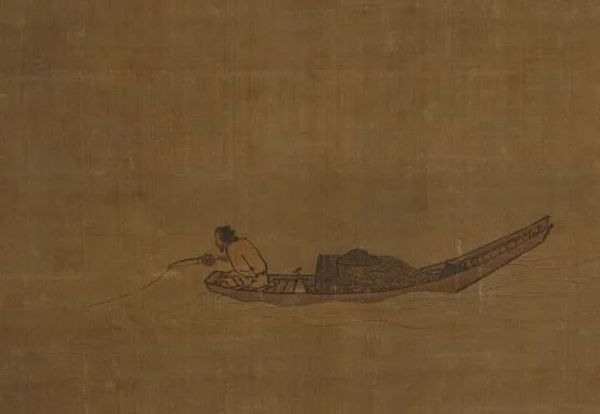
(Biography) Ma Yuan's "Lonely Fishing in the Cold River" by Ma Yuan in the Southern Song Dynasty
"Lonely Fishing in the Cold River" is said to be a landscape painting created by Ma Yuan in the Song Dynasty. In the painting, the author uses rigorous iron line drawing to draw a flat boat on which an old man is leaning over to fish. Water patterns are drawn beside the boat with a few strokes of light ink, and the surrounding is blank. The painter painted very little, but the picture was not empty. On the contrary, it makes people feel that the river is vast and the cold is pressing. Moreover, I also feel that there is an indescribable interest in the blank space, whether it is empty and quiet, or depression and indifference, which is really inexhaustible. This poetic and intriguing realm is the result of the combination of the painter's mind and nature, and in art it is the result of the combination of the virtual and the real.
Biography of Zhao Chang's "The Scroll of Bamboo Insects"
Due to the advocacy of the Royal Academy of Painting, the flourishing of flower-and-bird painting was triggered. Under the stable political situation in the Northern Song Dynasty, the painters lived a carefree life and were full of a strong interest in natural things. They were good at borrowing paintings of flowers and birds to express their emotions. During this period, most flower and bird painters paid more attention to the objective depiction of natural objects, and took wild flowers and birds in nature as their creative themes.
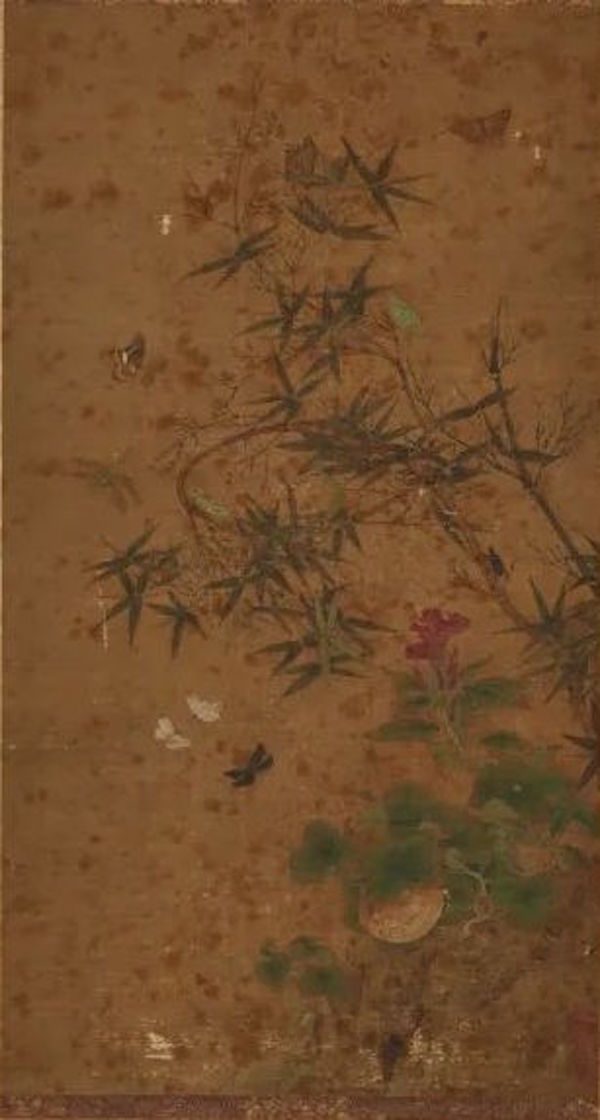
(Biography) "Bamboo Insect Scroll" by Zhao Chang of the Southern Song Dynasty

"Bamboo Insect Scroll" (detail)
Zhao Chang likes to cut branches, flowers and plants, is very rich in business, and has outstanding achievements in coloring. When the flower and bird paintings of the Huang family were popular in the court, he used a vibrant and lively brush to express wild and interesting natural flowers, cordyceps, and butterflies, reflecting his great personality. bird-and-flower style. In this "Bamboo Insect Scroll", the author uses delicate brushwork and bright colors to realistically depict the curved bamboo, as well as the surrounding sweet potatoes, cockscombs, butterflies, dragonflies, golden bells, textile girls and other grass and insects. It is generally believed that the flowers and insects depicted in the grass and insect paintings have their own meanings. For example: the meaning of melon is that the descendants will prosper for a long time, and the cockscomb and the grasshopper represent the auspicious meaning of "official and official". Although there is no grasshopper in this picture, it is presumed that the cockscomb is used to express the meaning of standing out.
Biography of Chen Rong's "Five Dragons Scroll"
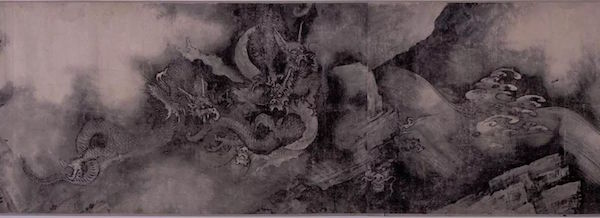
(Biography) "Five Dragons Scroll" by Chen Rong in the Southern Song Dynasty (part)
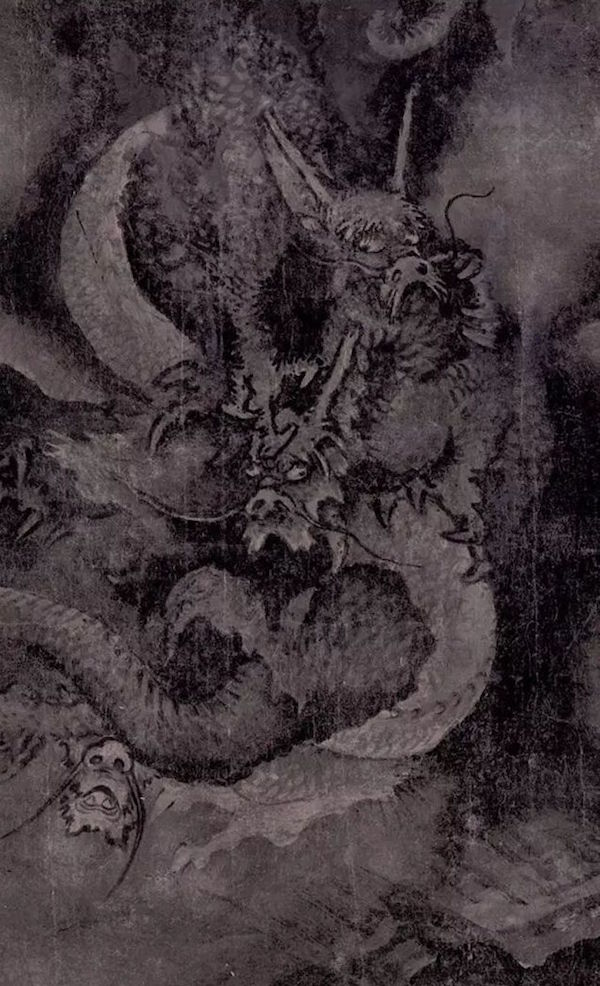
"Five Dragons Scroll" (detail)
At the end of the "Five Dragons Scroll", there is a seal of "Suo Zhai", which is said to be the work of Chen Rong. "Five Dragons Scroll" depicts five dragons, which are divided into rocks, clouds and rapids. The dynamics of the five dragons are varied, vivid, eerie and imaginative. In the composition, the virtual and the real complement each other, there is tension and relaxation, and the momentum is amazing.
the second term:
Li Gonglin's Five Horses Scroll
The second phase of exhibits will be on display from October 18th. Among them, the most interesting exhibit is undoubtedly Li Gonglin's "Five Horses Scroll".
The painting scroll of "Five Horses" is divided into five paragraphs. The first four paragraphs are inscribed by Huang Tingjian, a calligrapher of the Northern Song Dynasty, and the end of the scroll has Huang's postscript. ). This volume was collected by the Neifu in the Southern Song Dynasty, entered the Yuan and Ming Dynasties, and was handed over by Ke Jiusi and Zhang Tingfa. In "Shiqu Baoji Re-editing".
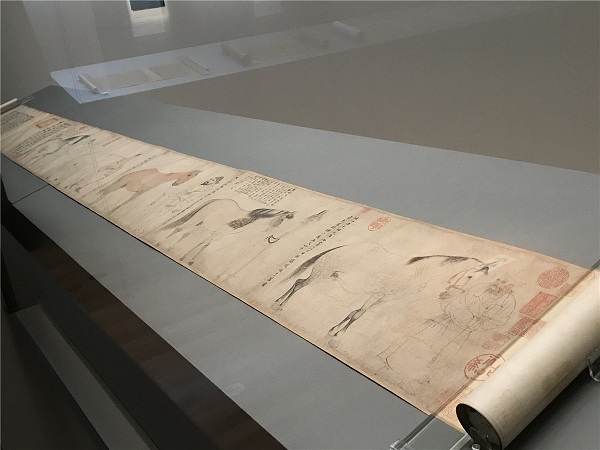
Li Gonglin's "Five Horses" exhibited at the Tokyo National Museum, Japan in 2019
The "Five Horses Scroll" has survived for more than 900 years and has been circulated in an orderly manner. It was originally collected by the Qing Palace. During the Republic of China, the last emperor, Pu Yi, stole it out of the palace in the name of rewarding Pu Jie. According to Zhang Boju's "Spring Outing Trivia", when Puyi lived in Zhangyuan, the Japanese concession in Tianjin, the Japanese obtained Song Liang Kai scrolls with 20,000 days of gold. This matter was handled by Chen Baochen at the time. After the event was completed, a certain Japanese marquis wanted to dedicate the "Five Horses" volume of Li Gonglin's 40,000 Japanese gold to the Japanese emperor. At this time, Puyi was willing to sell 400,000 yuan per day for 40 paintings and calligraphy, while "Five Horses" did not ask for the price and dedicated it to the Emperor of Japan. This matter was handled by Chen Baochen again, so he gave 40 paintings and calligraphy to Chen Baochen's nephew Liu Kechao in Puyi's name. Liu used four of them to mortgage 40,000 yuan to Tianjin Salt Industry Bank, including "Autumn Mountain Pingyuan Map", "Five Horses Map", "Copy Huai Su Shu" and "Yao Mountain Autumn Ji Map". Two months after the deposit, Liu returned 10,000 yuan and took the "Five Horses". Since then, where and who hides the "Five Horses" has been covered by clouds and fog. After World War II, it was also claimed by Japanese collectors to be destroyed by war. Until 2019, the Tokyo National Museum suddenly displayed "Five Horses" donated by anonymous collectors in the exhibition "Yan Zhenqing: Beyond Wang Xizhi's Famous Pens", which shocked countless calligraphy and painting lovers. This exhibition of fine painting and calligraphy is also the second public exhibition of "Five Horses Scroll".
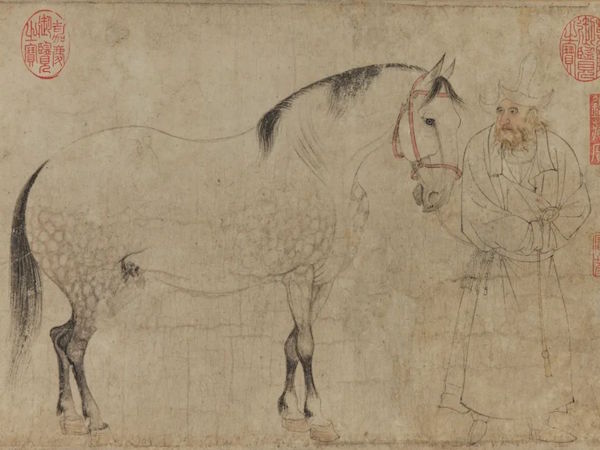
"The limelight" in Li Gonglin's "Five Horses Scroll"
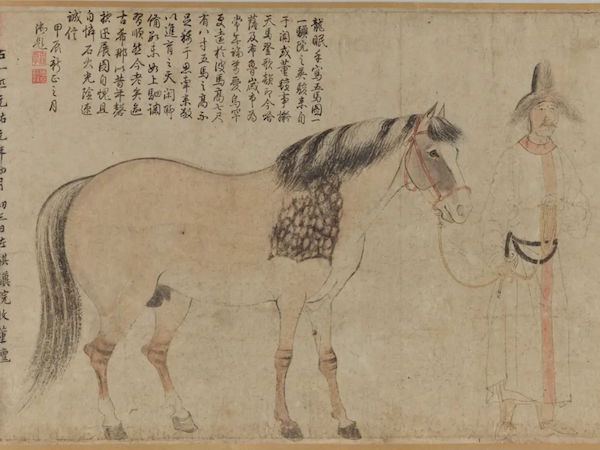
"Golden Arms Cong" in Li Gonglin's "Five Horses Scroll"

"Good head red" in Li Gonglin's "Five Horses Scroll"

"Shine the Night White" in Li Gonglin's "Five Horses Scroll"
"Five Horses" depicts five horses from the Western Regions that were paid tribute to the Northern Song Dynasty in the style of line drawing, each led by a Xi official. There is no author's seal in the painting. The first 4 horses and the latter have the horse's name, origin, age, and size signed and inscribed by Huang Tingjian. The names of these horses that were paid tribute by the countries in the Western Regions were in sequence "Lightning Cong", "Jinshan Cong", "Haotouchi", "Zhaoyebai", and the fifth horse was anonymized. flower". The first three of the five Xi officials were dressed in Western costumes, and the last two were Han Chinese.
Huang Tingjian's inscription and postscript: I have tried to comment on the characters of Bo Shi. It seems that there are some people in the Southern Dynasties. However, the sergeants and officials of the dynasty often sighed that Bo Shi was in the pavilion for a long time and was only burdened by calligraphy and painting. Yu told him: "People in the hills and valleys of Bo Shi have a reputation for being hot for a while, but they don't work hard when they come from Xuanmian." This horse, Chanjun, is quite similar to my friend Zhang Wenqian's writing skills, and Qu Tan's so-called know the whip shadow. Huang Lu Zhishu.

The fifth horse "Manchuan Flower" in Li Gonglin's "Five Horses Scroll"
However, why the fifth horse in "Five Horses" does not have the name of the horse inscribed by Huang Tingjian? Qianlong said in the postscript that the fifth horse is not the original work of Li Gonglin.
Qianlong's postscript: The first four horses all bear their names and where they came from, and this is the only one that is called Manchuan Huaye in Zeng's postscript? The inscription is not a picture of the genuine work, and if it is used to dazzle the viewer, it is also the name of Gonglin to cut off the tail of the mulberry, and there is no room for it, which is also the proof. Royal pen.
The famous art historian and professor at the Institute of Oriental Culture, Tokyo University, Mr. Itakura Shoji, once said in an interview with the media, "The Five Horses Scroll is the only surviving piece that shows the high reproducibility and high reproducibility that painting in the Northern Song Dynasty can achieve. A work of high expressiveness blending—on the one hand, it pays attention to the reproducibility of the depicted objects, and on the other hand, it shows the pursuit of the effect of brush and ink by literati painters, which are the two most important directions of painting in the Northern Song Dynasty.”
Liang Kai's "Li Bai Yin Travel Chart Scroll"

Part of Liang Kai's "Li Bai Yin Travel Chart"
Influenced by his teacher Jia Shigu in his early years, Liang Kai learned Li Gonglin's line drawing method, and has the reputation of "green out of blue". After middle age, he learned from Shi Ke's painting method, and reduced the thin line to the ink and wash brush, breaking through the "school style" style of painting, simplifying the lines, succinct and expressive, and creating one of the eighteen strokes, the "reduced brush stroke".
"Li Bai Xing Yin Tu" is a representative work of Liang Kai's reduced-stroke figure painting. In the painting, Li Bai is standing sideways, with his back to the sky, his poetic feelings are in his heart, and he is alone in contemplating and chanting sentences, the so-called "drinking alone under the moon". At first glance, it looks like it was drawn with a few strokes, but if you look closely, you can see that the strokes are all intricately designed. The head is lightly depicted with thin lines, the robes and the thin lines of the head complement each other, the lines are extraordinarily rich, the combination of virtual and real, the change of shades, and the cadence, so that the characters are no longer isolated on the paper, but integrated into the background, subtly expressing the poet Li Bai was in a state of independence between heaven and earth. The uncut and elegant lines show Li Bai's unrestrained romance.
Mi Fu's "Three Books of Running Script"
Mi Fu's "Three Tie Volumes of Running Script" is a book of his early years. The volume contains three posts: "Shuhui Post" (also known as "Secret Play Post"), "Li Taishi Post" and "Zhang Jiming Post".

Mi Fu's "Three Books of Running Script"
"Shuhui Tie" (also known as "Secret Play Tie"): " [Shou Que] Yu Shixing's father is a bureaucrat, and his servant and Shuhui are Daiya, who share the same interests in literature and art. Therefore, it was given as a secret game, and the title was to show that the children and grandchildren of the two surnames will be worth each other in the future. Xiangyang Mifu Yuanzhang Ji. Shuhui's sons Daonu, Denu, and Qingnu. The servant's sons Ao'er, Dongyang, and Sanxiong. "
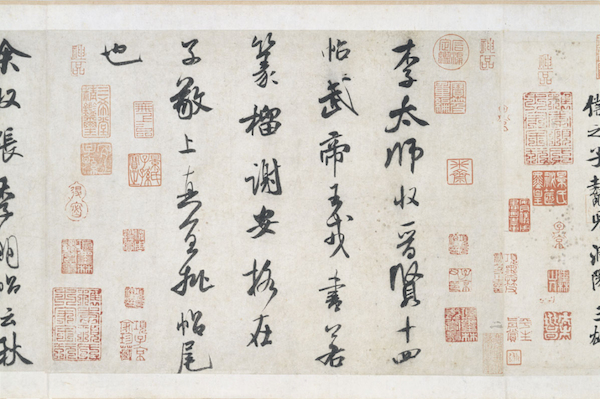
Mi Fu's "Three Books of Running Script"
"Li Taishi Post": " Li Taishi received the "Fourteen Posts of Jin Xian". Emperor Wu and Wang Rong Shuruozhuan. Xie Ange is on Zijing. It is really appropriate to approve the end of the post. "
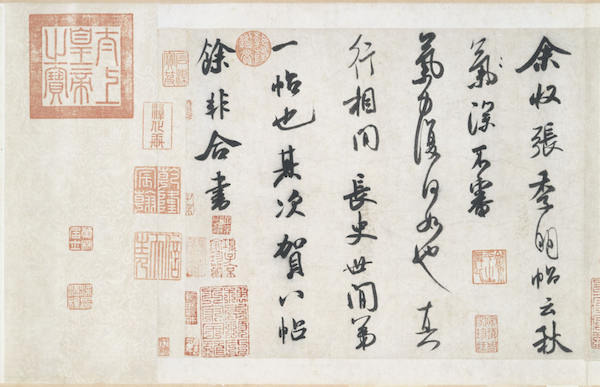
Mi Fu's "Three Books of Running Script"
"Zhang Jiming Post": " I have received Zhang Jiming's post, saying that 'the autumn is deep, and it is not necessary to judge the strength'. It is the first post in the world in the long history. Next, "He Ba Post", Yu Feiheshu. "
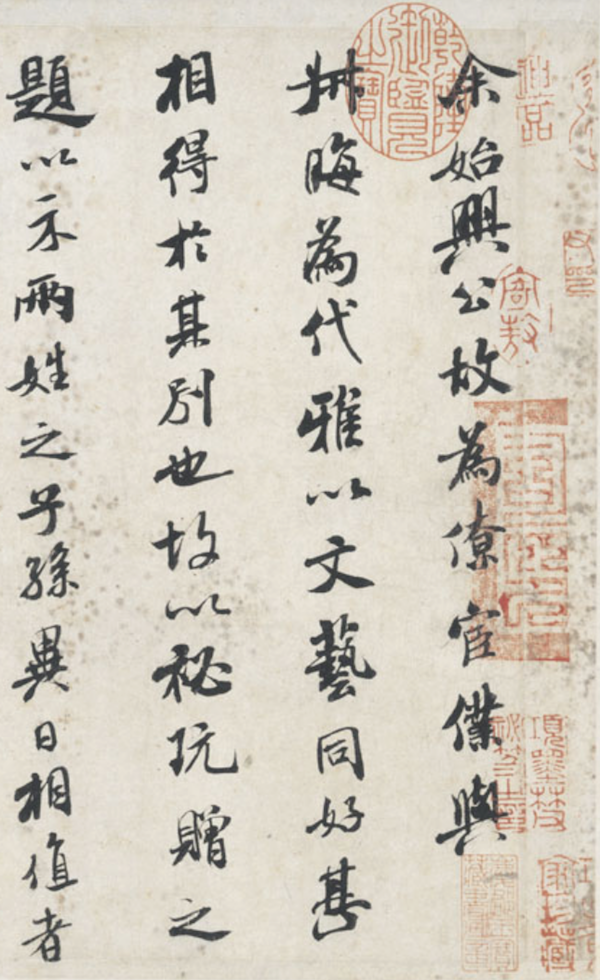
Mi Fu's "Three Posts in Running Script" (detail)
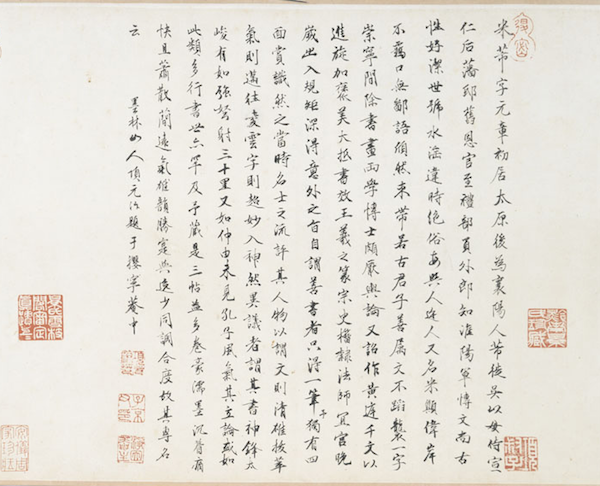
Xiang Yuanbian's Inscription and Postscript to Mi Fu's "Three Posts in Running Script"
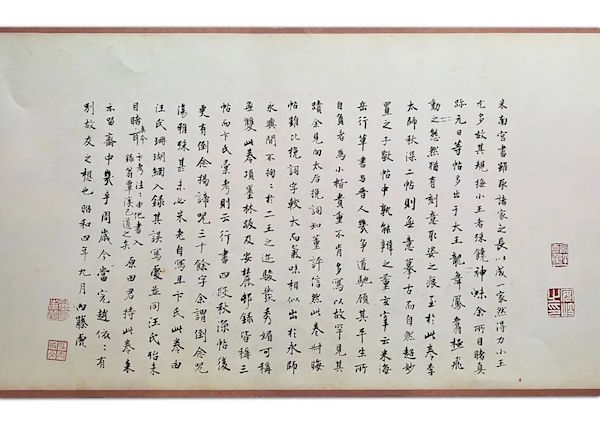
Mi Fu's "Three Posts in Running Script" inscription by Naito Torajiro
It is reported that Mi Fu's three-posted scrolls were frequently recorded during the Ming and Qing dynasties, such as Ming Wang Pingyu's "Coral Net" legal book inscription volume six, Yu Fengqing's "Yu's painting and calligraphy inscriptions" volume four, Qing Wu Qizhen's "Calligraphy and Painting Notes" volume four, Bian Yongyu "Bian Yongyu" The eleventh volume of Shigutang's Calligraphy and Painting Collection Examination (recorded from "Coral Net"), the first volume of Anqi's "Moyuan Huiguan" law book, etc. In the above-mentioned books, there are either only one post, or four posts (after "Zhang Jiming Post", there is the post "Reciting the Mantra of Revealing the Truth"), or seven posts. Until the Ming Dynasty, when Xiang Yuanbian collected it, there were three copies (see Xiang's postscript at the back of the volume), which was the later An's collection (see "Moyuan Huiguan"). Therefore, it is suspected that Mi Fu's three writings have been repeatedly divided, disassembled, assembled and re-framed in the late Ming and early Qing dynasties. This calligraphy work was later collected by Harada Goro, Abe Fangjiro, and Abe Kojiro, and finally became the collection of the Tokyo National Museum.
List of key exhibits
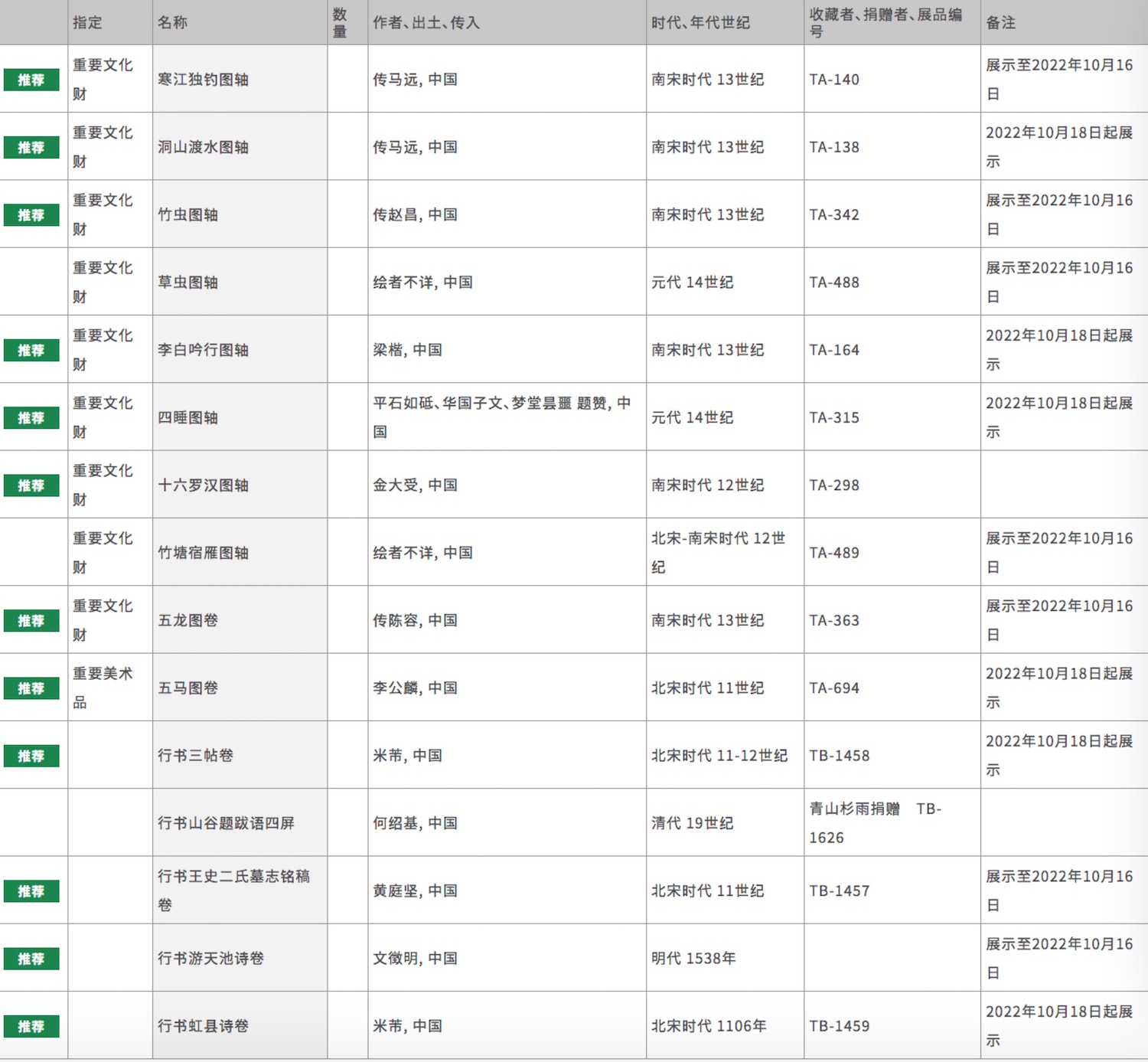
List of key exhibits
It is worth mentioning that, along with "Chinese Paintings and Calligraphy - Song Dynasty Paintings and Calligraphy and Their Inheritance and Development", there is also "Starting a Retrospective Journey of Ancient Silk Fabrics with the Dagu Expedition Team", which tells the story of the Dagu Expedition Team's journey from Dunhuang, Gansu Province, China. And unearthed silk fabrics obtained in Turpan, Xinjiang Uygur Autonomous Region. In October, to commemorate the 150th anniversary of its founding, the Tokyo National Museum will also hold the "Tokyo National Museum National Treasure Gathering". At that time, all 89 national treasures in the collection, as well as the essence of other collections and historical materials, will be brought together to show the whole picture of the 150-year-old Tokyo National Museum. .
The exhibition "Excellent Chinese Painting and Calligraphy - Song Dynasty Painting and Calligraphy and Its Inheritance and Development" will be on display until November 13.
(This article is based on the official website of the Tokyo National Museum, Japan, the previous related reports and exhibitions of The Paper, etc.)
